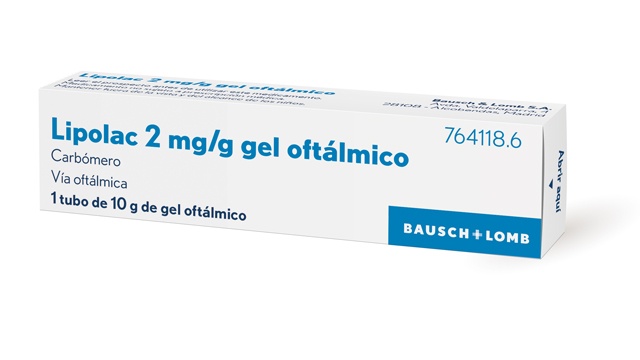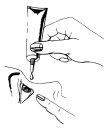

LIPOLASIC 2 mg/g OPHTHALMIC GEL


How to use LIPOLASIC 2 mg/g OPHTHALMIC GEL
Introduction
Package Leaflet: Information for the User
Lipolasic 2 mg/g Ophthalmic Gel
Carbomer
Read the entire package leaflet carefully before starting to use this medication,as it contains important information for you.
Follow the administration instructions for the medication contained in this package leaflet or as indicated by your doctor or pharmacist.
- Keep this package leaflet, as you may need to read it again.
- If you need advice or more information, consult your pharmacist.
- If you experience side effects, consult your doctor or pharmacist, even if they are side effects not listed in this package leaflet. See section 4.
- You should consult a doctor if it worsens or does not improve.
Contents of the Package Leaflet
- What is Lipolasic and what is it used for
- What you need to know before starting to use Lipolasic
- How to use Lipolasic
- Possible side effects
- Storage of Lipolasic
- Contents of the pack and further information
1. What is Lipolasic and what is it used for
Lipolasic is a highly viscous white gel that contains a lubricant used as a substitute for natural tears. Your eyes normally produce enough natural tears to move easily and comfortably. If your eyes do not produce enough tears, they can become dry, red, and painful. Lipolasic will help keep your eyes comfortable.
Lipolasic is a highly viscous gel that forms a protective layer over the eye and keeps its surface moist.
It is easy and comfortable to use and is especially suitable for the symptomatic treatment of severe dry eye.
You should consult a doctor if it worsens or does not improve.
2. What you need to know before starting to use Lipolasic
Do not use Lipolasic
- if you are allergic to carbomer or any of the other components of this medication (listed in section 6).
Warnings and precautions
Consult your doctor or pharmacist before starting to use Lipolasic.
Children and adolescents up to 18 years
In clinical practice, the safety and efficacy of Lipolasic have been established in children and adolescents at the recommended dose in adults, but no clinical trial data are available.
Use of other medications
Tell your doctor or pharmacist if you are using, have recently used, or may need to use any other medication.
When Lipolasic is used at the same time as other eye drops or ointments, a time interval of approximately 15 minutes should be left between the use of these other medications and Lipolasic, which should always be the last medication applied.
Pregnancy and breastfeeding
If you are pregnant or breastfeeding, think you may be pregnant, or plan to become pregnant, consult your doctor or pharmacist before using this medication.
You may be recommended this medication, but you may also be able to use an alternative.
Driving and using machines
As with all eye preparations, you may have blurred vision for a short time after applying the gel. Wait until your vision is clear before driving or using machines.
Contact lenses
To avoid streaks or clumps of gel on the contact lenses, you should remove them before applying Lipolasic. You can put them back 30 minutes later.
3. How to use Lipolasic
Follow the administration instructions for this medication as indicated by your doctor or pharmacist. If in doubt, consult your doctor or pharmacist again.
The recommended dose is to apply one drop to the corner of the eye closest to the nose, 3-5 times a day, and approximately 30 minutes before bedtime.
Follow these instructions carefully:
- Wash your hands well.
- Remove the cap.
- Look up and gently pull down the lower eyelid.
- Hold the Lipolasic tube just above your eye and gently squeeze until the gel falls into the space between the eyeball and the lower eyelid.
- Release the lower eyelid and move your eye while it is open to ensure the gel covers the entire eye.
- Repeat the process in the other eye, if necessary.

Children and adolescents up to 18 years
In clinical practice, the safety and efficacy of Lipolasic have been established in children and adolescents at the recommended dose in adults, but no clinical trial data are available.
If you use more Lipolasic than you should
If you have applied too much Lipolasic, rinse the gel from your eyes.
If you forget to use Lipolasic
Do not apply a double dose to make up for forgotten doses.
If you stop treatment with Lipolasic
The dry eye disorder may worsen if it is treated incorrectly or inadequately.If you have any other questions about the use of this medication, ask your doctor or pharmacist.
4. Possible side effects
Like all medications, this medication can cause side effects, although not everyone will experience them. Your eyes may hurt a little when you apply the gel, and your vision may become blurred. These effects will disappear in a few minutes.
Some reports of allergies (hypersensitivity) have been received after administration of Lipolasic, due to one of the excipients in the composition (may affect 1 in 10,000 people).
Other side effects that have been rarely reported (may affect 1 in 10,000 people) are sticky eyelids, conjunctivitis (red eyes), speckling (or dots) on the cornea (the surface of the eye), swollen eyes, burning, itching, and eye irritation.
If any of the side effects you experience are serious or if you notice any side effect not mentioned in this package leaflet, tell your doctor or pharmacist.
Reporting side effects
If you experience any type of side effect, consult your doctor or pharmacist, even if it is a possible side effect not listed in this package leaflet. You can also report them directly through the Spanish Pharmacovigilance System for Human Use Medicines: https://www.notificaram.es.
By reporting side effects, you can help provide more information on the safety of this medication.
5. Storage of Lipolasic
Keep this medication out of the sight and reach of children.
Do not use this medication after the expiration date stated on the packaging after CAD. The expiration date is the last day of the month indicated.
Do not store above 25°C (room temperature)
Lipolasic is sterile until the tube is opened for the first time. It is important to keep the tube as clean as possible during use.
The tube has a flat cap, which allows it to stand upright.
Discard the remaining contents 28 days after opening the tube. It may be useful to write the date you first opened the tube on it.
Remember that this medication is for you. Do not give it to anyone else.
Medications should not be disposed of through wastewater or household waste. Deposit the packaging and any unused medication in the pharmacy's SIGRE point. If in doubt, ask your pharmacist how to dispose of the packaging and any unused medication. This will help protect the environment.
6. Further information
Composition of Lipolasic
The active ingredient is carbomer. Each tube contains 2.0 mg of carbomer per gram of gel.
The other ingredients are cetrimide, sorbitol, medium-chain triglycerides, sodium hydroxide (for pH adjustment), and water for injectable preparations.
Lipolasic ophthalmic gel contains the preservative cetrimide.
Appearance and packaging of the product
Lipolasic ophthalmic gel is a highly viscous white gel.
Package sizes:
Tubes of 5g of gel. Boxes containing 1 or 3 tubes of 5g of ophthalmic gel.
Tubes of 10g of gel. Boxes containing 1 or 3 tubes of 10g of ophthalmic gel.
Not all package sizes may be marketed.
Marketing authorization holder and manufacturer
Marketing authorization holder
Bausch & Lomb S.A.
Avda. Valdelaparra, 4
28108 – Alcobendas, Madrid
Spain
Manufacturer
Dr. Gerhard Mann
Chem.-pharm. Fabrik GmbH
Brunsbuetteler Damm 165-173
13581 Berlin (Germany)
Laboratoire Chauvin
Zone Industrielle de Ripotier
50 Avenue Jean Monnet
07200 Aubenas (France)
This medication is authorized in the Member States of the European Economic Area under the following names:
United Kingdom Liposic
Belgium Liposic
Greece Liposic
Spain Lipolasic
France Liposic
Ireland Liposic
Italy Lipovisc
Portugal Liposic
Date of the last revision of this package leaflet:June 2018
Detailed and updated information on this medication is available on the website of the Spanish Agency for Medicines and Health Products (AEMPS) http://www.aemps.gob.es/
Other information
Lipolasic is used for the symptomatic treatment of "dry eye", which is a dehydration of the eye surface as a result of alterations in tear secretion or tear quality. Dry eye disease can also be caused when the eyelids cannot be partially or fully closed.
This disease is so common that one in five patients who visit an ophthalmologist suffer from it. There are many factors that can cause it, such as reduced tear production in old age, air conditioning, computer work, hormonal changes during menopause, etc. Environmental and climatic factors can also play a role in the development of dry eye.
What do we mean by "dry eye"?
During the day, we blink an average of 14,000 times. With each eyelid movement, a very thin film of tears is distributed over the surface of the eyeball, keeping it smooth, clean, and moist, and protecting the eye from contaminants. When the volume or composition of the tear film is altered, dehydration (drying) of the cornea and conjunctiva occurs, and the symptoms experienced by the patient are burning, dry eye sensation, foreign body sensation or pressure, and sensitivity to light.
Lipolasic is a soothing gel that moisturizes the eyes and provides lubrication to the eyes and eyelids similar to that of tears. The carbomer in Lipolasic gel increases the thickness of the gel, making it stay in contact with the eye for a longer period.
Your ophthalmologist has prescribed a tear substitute for the relief of your eye discomfort. In addition to using it consistently, you should follow these recommendations:
- Ventilate your apartment or house several times a day.
- Make sure to drink enough.
- Go out for fresh air frequently.
- Do not direct air vents towards your eyes.
- Take breaks when working in front of a computer screen.
However, it is also important that you regularly consult your ophthalmologist for follow-up, as dry eye can lead to a serious disease if it is treated incorrectly or inadequately.
- Country of registration
- Active substance
- Prescription requiredNo
- Manufacturer
- CompositionHIDROXIDO DE SODIO (E 524) (0,800 mg mg), SORBITOL (48,51 mg mg)
- This information is for reference only and does not constitute medical advice. Always consult a licensed doctor before taking any medication. Oladoctor is not responsible for medical decisions based on this content.
- Alternatives to LIPOLASIC 2 mg/g OPHTHALMIC GELDosage form: EYEDROP, 5.5 mg sodium chloride; 3 mg hypromellose/mlActive substance: artificial tears and other indifferent preparationsManufacturer: Alcon Healthcare S.A.Prescription not requiredDosage form: EYEDROP, 3.2 mg/mlActive substance: artificial tears and other indifferent preparationsManufacturer: Bausch & Lomb S.A.Prescription not requiredDosage form: EYE DROP, 3.2 mg/mlActive substance: artificial tears and other indifferent preparationsManufacturer: Bausch & Lomb S.A.Prescription not required




